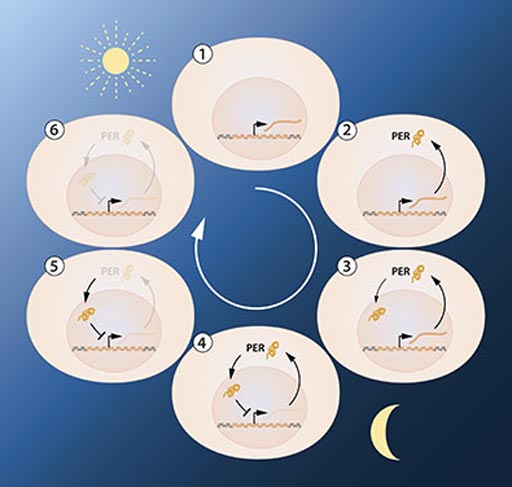Nobel Prize Awarded for Circadian Clock Discoveries
By LabMedica International staff writers
Posted on 19 Oct 2017
The 2017 Nobel Prize in Physiology or Medicine – jointly awarded to scientists Jeffrey C. Hall, Michael Rosbash, and Michael W. Young – recognizes their fundamental discoveries about molecular mechanisms controlling the circadian rhythm.Posted on 19 Oct 2017
With exquisite precision, our inner clock adapts our physiology to the dramatically different phases of the day. The clock is involved in regulating critical functions such as aspects of behavior (e.g. feeding), hormone levels, sleep patterns, blood pressure, body temperature, and metabolism. Our wellbeing is affected when there is a temporary mismatch between our external environment and this internal clock; for example when we travel across several time zones and experience "jet lag." There are also indications that chronic misalignment between our lifestyle and rhythms dictated by this inner daily timekeeper is associated with increased risk for various diseases.

Image: A simplified illustration of the inhibitory feedback regulation of the period gene, showing the sequence of events during a 24h oscillation, during which PER protein prevents its own synthesis and thereby regulate its own level in a continuous, cyclic rhythm (Photo courtesy of Mattias Karlén / The Nobel Committee for Physiology or Medicine).
During the 1970's, using the fruit fly Drosophila as a model organism, Seymour Benzer and his student Ronald Konopka asked whether it would be possible to identify genes that control the circadian rhythm. They demonstrated that mutations in an unknown gene disrupted the circadian clock of the flies. They named this gene “period.”
Also using Drosophila, the 2017 Nobel Laureates – Jeffrey C. Hall, who has been at Brandeis University (Waltham, MA, USA) since 1974 (and associated with University of Maine (USA) since 2002); Michael Rosbash, who has been at Brandeis University since 1974, and Michael W. Young, who has been at the Rockefeller University (New York City, NY, USA) since 1978 – aimed to discover how the clock works, to elucidate the mechanism governing this self-sustaining clockwork inside the cell.
In 1984, they succeeded in isolating the “period” gene. Jeffrey Hall and Michael Rosbash then went on to discover that PER, the protein encoded by period, accumulated during the night and was degraded during the day. Thus, PER protein levels oscillate over a 24-hour cycle, in synchrony with the circadian rhythm.
The next key goal was to understand how such circadian oscillations could be generated and sustained. Jeffrey Hall and Michael Rosbash hypothesized that the PER protein blocked the activity of the period gene. They reasoned that by an inhibitory feedback loop, PER protein could prevent its own synthesis and thereby regulate its own level in a continuous, cyclic rhythm.
The model was tantalizing, but a few pieces of the puzzle were missing. To block expression of the period gene, PER protein, which is produced in the cytoplasm, would have to reach the cell nucleus, where the genetic material is located. Jeffrey Hall and Michael Rosbash had shown that PER protein accumulates in the nucleus during night, but how did it get there? In 1994 Michael Young discovered a second clock gene, timeless, encoding the TIM protein that was required for a normal circadian rhythm. In elegant work, he showed that when TIM bound to PER, the two proteins were able to enter the cell nucleus where they blocked period gene expression, thus closing the inhibitory feedback loop.
Such a regulatory feedback mechanism explained how this oscillation of cellular protein levels occurs, but questions lingered. What controlled the frequency of the oscillations? Michael Young identified yet another gene, doubletime, encoding the DBT protein that delayed the accumulation of the PER protein. This provided insight into how an oscillation is adjusted to more closely match a 24-hour cycle.
The paradigm-shifting discoveries by the laureates established key mechanistic principles for the circadian biological clock. During the following years other molecular components of the clockwork mechanism were elucidated that helped explain its stability and function. For example, the laureates identified additional proteins required for the activation of the period gene, as well as for the mechanism by which light can synchronize the clock.
All known multicellular organisms utilize a similar mechanism to control circadian rhythms. A large proportion of our genes are regulated by the circadian biological clock and, consequently, a carefully calibrated circadian rhythm adapts our physiology to the different phases of the day. Since the seminal discoveries by the three laureates, circadian biology has developed into a vast and highly dynamic research field, including implications for our health and wellbeing.














